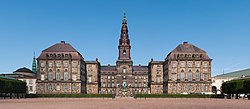Helvetiania

|
Helvetianian Confederation Helvetianische Konfederatio (Plaat) Capital: None (de jure)
Gentsch (de facto) Population: 15 845 645 (2018) Motto: Freiheit, Fortschritt, Fortune |
Loading map... |
Helvetiania, officially the Helvetianian Confederation (Mergan: Helvetianische Konfederatio), is a country situated in eastern Uletha. The sovereign state is a federal republic which consists of seven cantons. It is bordered by Mergania to the south, the Madean Union and Wyster to the west, and Ostau to the east. Helvetiania is a member of the Eastern Ulethan Organization of Independent Allies (EUOIA).
Etymology
The name Helvetiania comes from the Helvetic League, a commercial and defensive confederation of market towns and merchant guilds in the Middle Ages, which had its seeds in east Helvetiania.
History
Helvetiania has existed as a state in its present form since the adoption of the Constitution of the Federal States in Helvetiania in 1809. The precursors of Helvetiania established a protective alliance in the 14th century (1354), forming a loose confederation of states which persisted for centuries. The first notable confederation on Helvetiania's territory was the Helvetic League.
Early history
- first settlement in Helvetiania is seen in xxx archaeological sites (around 45000 BC) which include a mammoth bone dwelling.
- modern human settlement in Helvetiania and its vicinity dates back to 27000 BC
Middle Ages and Helvetic League
The Helvetic League (Mergan: Helvetischer Bund) was a commercial and defensive confederation of market towns and merchant guilds in the east of Uletha. Growing from a few towns in eastern Helvetiania in the early 1200s, the league came to dominate maritime trade for several centuries along the coasts of the Scythian Sea and Darcodian Sea, but territories also stretched to the Kaspen Sea.
- Federal state
- Constitution of the Federal States in Helvetiania in 1809
- Modern history
Geography
 | |
|---|---|
| Geography of Helvetiania | |
| Continent | Uletha |
| Region | East Uletha |
| Population | 9350000 (2017) |
| Area | |
| • Total | 90415 km2 34910 sq mi |
| • Water (%) | 34 |
| Population density | 156.6 km2 267.8 sq mi |
| (custom label that appears in bold on the left side of the infobox) | (custom information that is defined by custom_label1) |
| (custom label that appears in bold on the left side of the infobox) | (custom information that is defined by custom_label1) |
| Time zone | +8:00 |
Helvetiania lies between latitudes 47.6° and 50.8° N, longitudes 131.4° and 139.2° E and has a total land area of 63000 km². Most areas of Helvetiania are flat and geographically very low relative to sea level, with the exception of hills in the central west. Since the early 17th century, large polder areas are preserved through elaborate drainage systems that include canals, dikes and pumping stations.
- Climate
- Nature
Politics
- Foreign relations and international institutions
- Military
Administrative divisions
7 cantons:
Economy
- Companies
- Science and technology
- Tourism
Agriculture
Large parts of Helvetiania's surface land consist of chernozem, the so-called black earth. The soil contains a high percentage of humus and high percentages of phosphoric acids, phosphorus and ammonia. It is very fertile and can produce high agricultural yields with its high moisture storage capacity. Chernozem is a resource that has made Helvetiania well known as a "breadbasket" and one of the most fertile regions in the world.
Transport
- Road transport
- Cycling
- Water transport
Public transport
- Transport: 1435mm (standard gauge), 25 kV, 50 Hz
Air transport
Zurchau Airport (Mergan: Flughafen Zurchau, WAAT: ZUR, ANACA: HZUR) is the largest international airport of Helvetiania and the principal hub of Helvetianic Airlines. It serves Zurchau and with its surface transport links much of the rest of the country. The airport is located 15 kilometers northwest of central Zurchau.
Demographics
- Language
- Education
- Healthcare
- Religion
Culture
- Architecture
- Art, literature and philosophy
- Cuisine
- Sports
See also
- links



